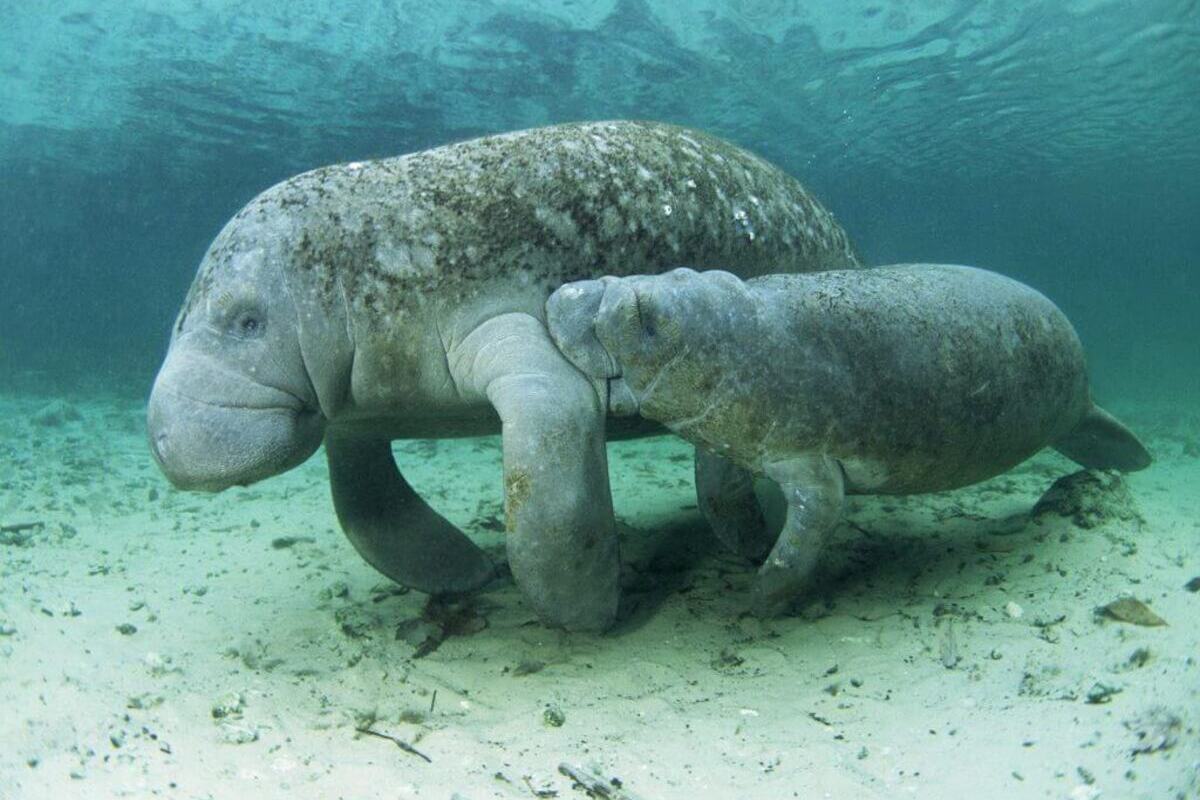Dugongs are marine mammals that fascinate not only with their unique appearance but also with their peaceful and gentle lifestyle. Often called sea cows, they are actually more closely related to elephants than to cattle. These mysterious creatures inhabit tropical coastal waters and have intrigued scientists and nature lovers for centuries. Below are some captivating facts about dugongs that you may not have known.
- Dugongs are the only living species in the family Dugongidae, which dates back more than 50 million years. Their extinct relatives were much larger, including the legendary Steller’s sea cow, which reached over 9 meters in length and weighed more than 10 tons.
- Dugongs are strictly herbivorous marine animals that feed primarily on seagrasses. They carefully select the most nutritious and tender species, often uprooting entire plants while feeding.
- Adult dugongs can grow up to 3 meters in length and weigh around 400 kilograms. A thick layer of fat under their skin helps them retain warmth in cooler waters.
- Dugongs have no hind limbs, and their front flippers are used for steering. Their broad, dolphin-like tail provides slow but efficient propulsion through the water.
- These animals can hold their breath underwater for up to six minutes, though they usually surface every two minutes to breathe. Their nostrils are located on top of the head, allowing them to breathe without fully emerging from the water.
- Female dugongs give birth to only one calf every 3 to 7 years, and the gestation period lasts over a year. A newborn dugong can swim within hours of birth and stays with its mother for up to two years.
- Dugongs communicate through various sounds such as clicks, whistles, and rumbles. These vocalizations help them stay in contact, especially in murky waters where visibility is limited.
- In ancient times, sailors often mistook dugongs for mermaids. From a distance, their graceful movements and rounded forms could create such illusions, especially during long and tiring voyages.
- Dugongs inhabit only the shallow coastal waters of the Indian Ocean and the western Pacific. They are most commonly found off the coast of Australia, but can also be seen in the Red Sea and along the eastern coast of Africa.
- These mammals are highly sensitive to environmental changes. Water pollution, boat traffic, fishing nets, and the destruction of seagrass habitats contribute to the rapid decline of their populations.
- Dugongs have few natural predators aside from humans. Occasionally, large sharks or orcas may prey on young or weakened individuals.
- They possess an extremely slow metabolism, which enables them to survive on relatively small amounts of food. Dugongs can spend up to eight hours a day grazing on seagrasses.
- In some cultures, dugongs hold spiritual or symbolic significance. For example, Indigenous communities in northern Australia consider them sacred beings, and traditional knowledge about them is passed down through generations.
- Dugongs have hair follicles on their skin that are remnants of their ancient ancestors. These follicles act as sensory receptors, helping detect even slight movements in the water.
- In many countries, dugongs are listed as endangered and are protected by law. Hunting them is illegal, and several marine reserves have been established to protect their natural habitats.
- Dugongs are known for their calm and docile temperament. They are non-aggressive and lead peaceful lives, avoiding conflicts with humans and other marine animals.
- These mammals are capable of migrating long distances in search of food or during seasonal movements. They navigate using Earth’s magnetic field, a trait shared with many other marine species.
- Observing dugongs in the wild plays a significant role in eco-tourism. Some regions offer special programs that allow tourists to view these animals without disturbing them.
- Dugongs can regenerate their teeth, which may be replaced several times throughout their lives. This is essential, as their diet consists of tough, fibrous plants that wear down their teeth.
- In ideal conditions, dugongs can live for over 70 years. However, due to numerous environmental threats, most wild dugongs have a lifespan of only 30 to 40 years.
These incredible facts about dugongs reveal the hidden world of these gentle marine giants. Although they have survived for millions of years, today they face growing dangers and need our protection more than ever. Preserving their populations and habitats is not only the responsibility of conservationists, but of anyone who values the uniqueness of the natural world. You may not have realized it, but even the smallest actions can help these peaceful creatures survive in the modern era.





